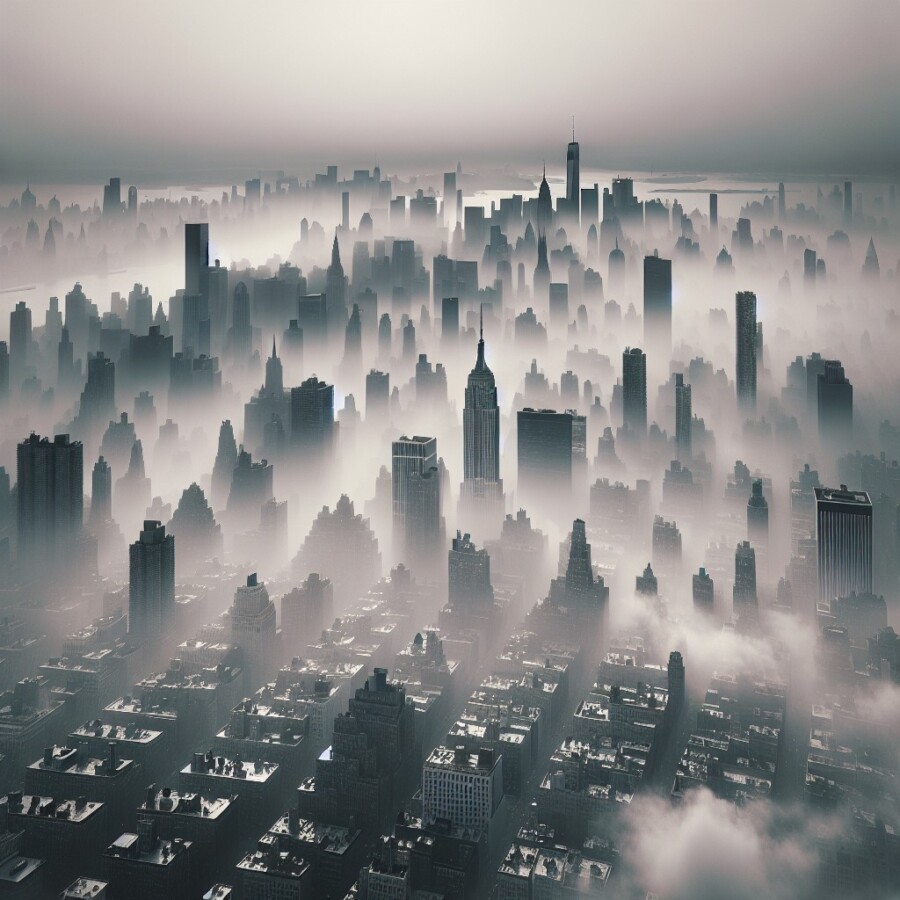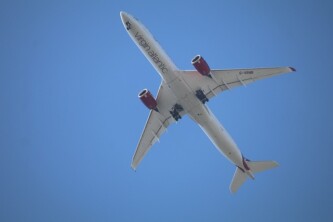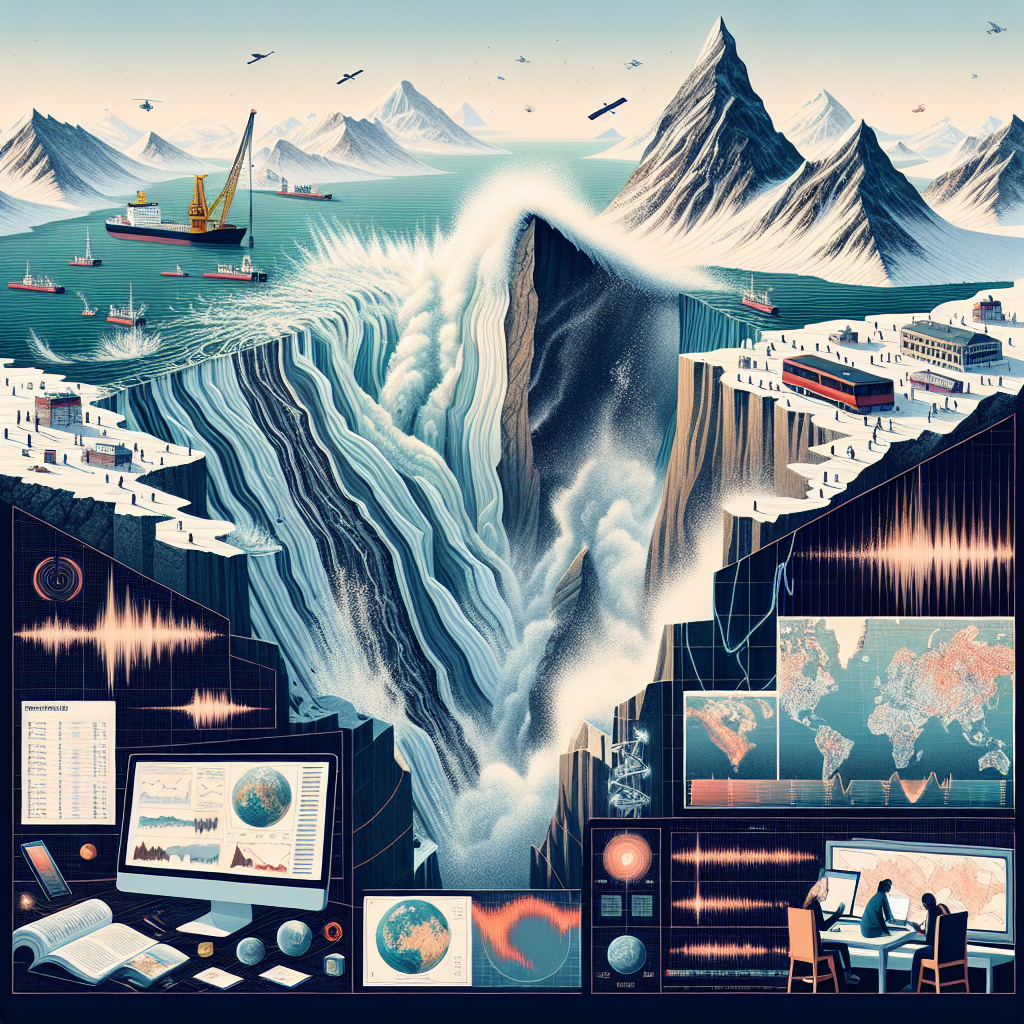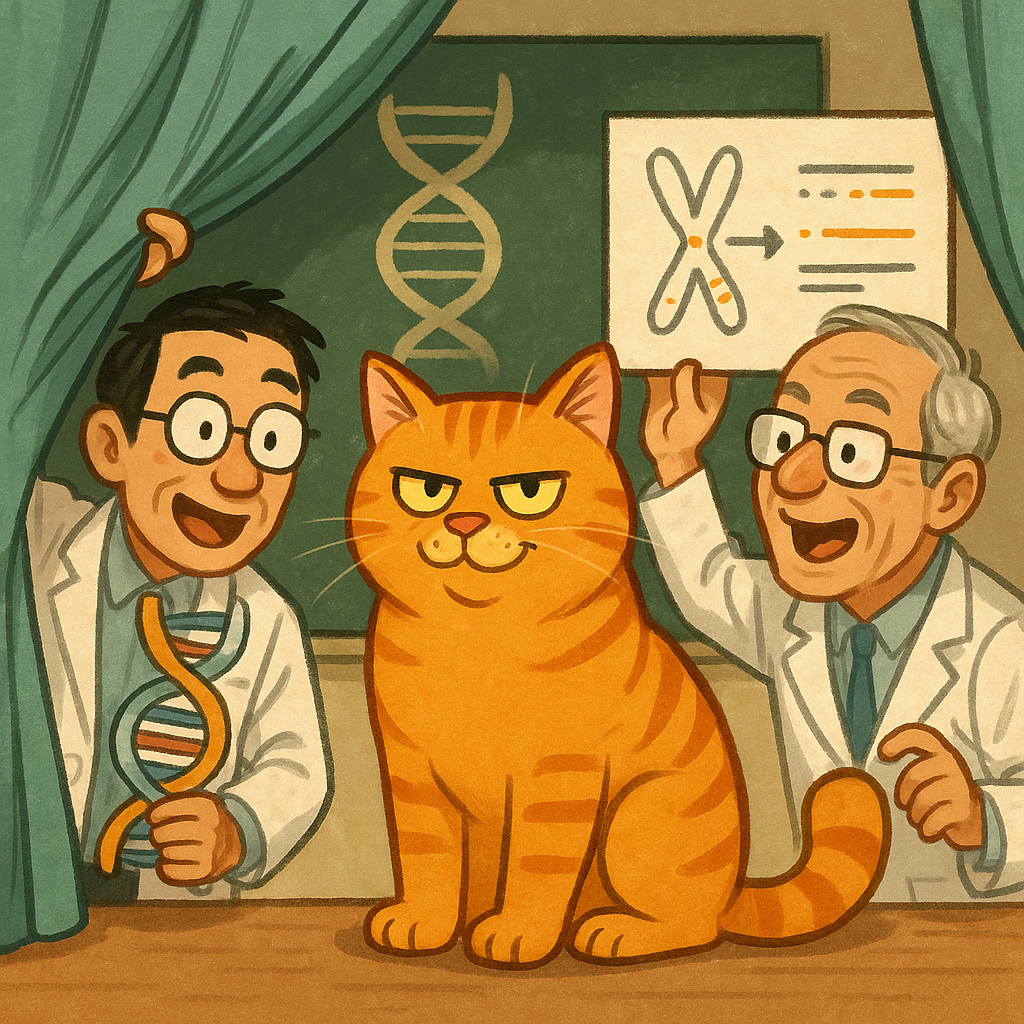New York City was covered in dense fog on Tuesday morning, creating a surreal sight of the city appearing to float on clouds. This phenomenon, known as ‘advection fog’, occurs when easterly winds blow over the cool waters of Long Island Sound. The wind then carries the fog inland, enveloping New York City and southern Connecticut.
The fog was so thick that it obscured the city skyline and made it difficult to see buildings and landmarks. This created a dream-like atmosphere, with the city appearing ethereal and mysterious. The foggy conditions also caused disruptions to transportation, with flights delayed and ferry services suspended.
Advection fog is a common occurrence in coastal areas, where cool air from the ocean meets warmer air over land. The temperature difference causes the moisture in the air to condense, forming fog. This type of fog is often thick and can reduce visibility to a few meters.
Despite the inconvenience caused by the fog, many New Yorkers and tourists took the opportunity to capture stunning photos and videos of the city shrouded in mist. The fog added a unique and enchanting element to the urban landscape, showcasing the beauty and diversity of New York City’s weather patterns.
As the day progressed, the fog gradually lifted, revealing the familiar skyline and allowing normal activities to resume. However, the memory of New York City transformed into a city on clouds will linger in the minds of those who witnessed this extraordinary weather event.
Original news source: Dense fog transforms New York into a city on clouds (BBC)
🎧 Listen:
Slow
Normal
Fast
📖 Vocabulary:
| 1 | surreal | Having an unreal, fantastic quality |
| 2 | advection | The transfer of heat or matter by the flow of a fluid, especially horizontally in the atmosphere or the sea |
| 3 | phenomenon | An observable event, especially something unusual or interesting |
| 4 | obscured | Made less visible or unclear |
| 5 | ethereal | Extremely delicate and light in a way that seems too perfect for this world |
| 6 | disruptions | Interruptions or disturbances in normal operations or activities |
| 7 | coastal | Related to areas adjacent to or near the sea |
| 8 | condense | To change from a gas or vapor to a liquid |
| 9 | visibility | The state of being able to see or be seen |
| 10 | inconvenience | A cause of trouble or difficulty |
| 11 | enchanting | Delightfully charming or attractive |
| 12 | diversity | The quality of being varied or different |
| 13 | urban | Pertaining to a city or densely populated area |
| 14 | linger | To remain present although gradually fading or disappearing |
| 15 | extraordinary | Beyond what is usual, ordinary, or regular |
Group or Classroom Activities
Warm-up Activities:
– News Summary
Instructions: Divide the class into small groups. Give each group a few minutes to read the article. Then, ask each group to write a brief summary of the article, highlighting the main points and key details. Afterward, have each group take turns presenting their summaries to the class.
– Opinion Poll
Instructions: Divide the class into pairs. Ask each pair to discuss their opinions on the phenomenon of advection fog in New York City. Have them take turns asking each other questions and sharing their thoughts and experiences related to foggy weather. Afterward, conduct a class-wide poll by asking students to raise their hands to indicate if they enjoy or dislike foggy weather. Encourage students to share their reasons for their opinions.
– Vocabulary Pictionary
Instructions: Write a list of vocabulary words from the article on the board. Divide the class into small groups and give each group a whiteboard or large sheet of paper. Assign one person from each group to be the “drawer”. The drawer will select a word from the list and draw a picture to represent it, while their teammates try to guess the word. The first team to correctly guess the word gets a point. Continue the game, rotating the role of the drawer within each group.
– Sketch It
Instructions: Divide the class into pairs. Ask each pair to choose a scene or image from the article that stood out to them. Have them take turns describing the scene to their partner in as much detail as possible. Afterward, ask each pair to draw the scene based on their partner’s description. Once the drawings are complete, have each pair compare their drawings to the original scene from the article and discuss any differences or similarities.
– Pros and Cons
Instructions: Divide the class into two groups. Assign one group to come up with a list of pros (advantages) of advection fog in New York City, and the other group to come up with a list of cons (disadvantages). Give each group a few minutes to brainstorm and write down their ideas. Then, have each group take turns sharing their lists with the class. Encourage students to discuss and debate the different perspectives presented.
🤔 Comprehension Questions:
1. What is advection fog and how does it form?
2. How did the fog affect transportation in New York City?
3. Why did the fog create a dream-like atmosphere?
4. Why is advection fog common in coastal areas?
5. How did people react to the foggy conditions in New York City?
6. How did the fog affect visibility in the city?
7. How did the foggy conditions impact flights and ferry services?
8. How long did it take for the fog to lift and return to normal?
Go to answers ⇩
🎧✍️ Listen and Fill in the Gaps:
New York City was covered in dense fog on Tuesday morning, (1)______ a surreal sight of the city appearing to float on clouds. This (2)______, (3)______ as ‘advection fog’, occurs when easterly winds blow over the cool waters of Long Island Sound. The wind then carries the fog inland, enveloping New York City and southern Connecticut.
The fog was so (4)______ that it obscured the city (5)______ and made it (6)______ to see buildings and landmarks. This created a dream-like atmosphere, with the city appearing ethereal and mysterious. The foggy conditions also caused (7)______ to transportation, with flights (8)______ and ferry services suspended.
Advection fog is a common occurrence in coastal areas, where cool air from the ocean meets warmer air over land. The temperature difference (9)______ the moisture in the air to condense, forming fog. This type of fog is often thick and can reduce visibility to a few (10)______.
Despite the inconvenience caused by the fog, many New Yorkers and tourists took the (11)______ to capture stunning photos and videos of the city shrouded in mist. The fog (12)______ a unique and enchanting element to the urban (13)______, showcasing the beauty and (14)______ of New York City’s weather patterns.
As the day progressed, the fog gradually lifted, revealing the familiar skyline and allowing normal activities to resume. However, the memory of New York City transformed into a city on (15)______ will (16)______ in the minds of those who witnessed this extraordinary weather event.
Go to answers ⇩
💬 Discussion Questions:
Students can ask a partner these questions, or discuss them as a group.
1. What is advection fog and how does it form?
2. Have you ever experienced advection fog? If so, where and how did it make you feel?
3. How do you think the foggy conditions would affect people’s daily routines and activities?
4. Do you find foggy weather to be calming or unsettling? Why or why not?
5. How do you think the foggy conditions would impact transportation in a city like New York?
6. Have you ever taken photos or videos of unusual weather conditions? If so, what did you capture and why?
7. Do you think foggy weather can add a sense of mystery and beauty to a city? Why or why not?
8. How would you feel if you were flying into or out of New York City during the foggy conditions? Why?
9. What other weather phenomena have you witnessed that made a place look different or unique?
10. Do you think experiencing unusual weather events can make people appreciate the beauty and diversity of nature? Why or why not?
11. How do you think the foggy conditions would affect tourism in New York City? Why?
12. Have you ever been in a situation where your plans were disrupted due to weather conditions? If so, how did you handle it?
13. Do you think it’s important for cities to be prepared for unusual weather events? Why or why not?
14. How would you describe the feeling of seeing a city appear to float on clouds?
15. Do you think weather events like this can create a sense of unity among people who experience them? Why or why not?
Individual Activities
📖💭 Vocabulary Meanings:
Match each word to its meaning.
Words:
1. surreal
2. advection
3. phenomenon
4. obscured
5. ethereal
6. disruptions
7. coastal
8. condense
9. visibility
10. inconvenience
11. enchanting
12. diversity
13. urban
14. linger
15. extraordinary
Meanings:
(A) The state of being able to see or be seen
(B) To remain present although gradually fading or disappearing
(C) Beyond what is usual, ordinary, or regular
(D) Pertaining to a city or densely populated area
(E) Interruptions or disturbances in normal operations or activities
(F) To change from a gas or vapor to a liquid
(G) Related to areas adjacent to or near the sea
(H) The transfer of heat or matter by the flow of a fluid, especially horizontally in the atmosphere or the sea
(I) An observable event, especially something unusual or interesting
(J) Having an unreal, fantastic quality
(K) Delightfully charming or attractive
(L) The quality of being varied or different
(M) A cause of trouble or difficulty
(N) Extremely delicate and light in a way that seems too perfect for this world
(O) Made less visible or unclear
Go to answers ⇩
🔡 Multiple Choice Questions:
1. What caused the dense fog in New York City?
(a) A sudden drop in temperature
(b) Pollution in the air
(c) Heavy rainfall
(d) Easterly winds blowing over the cool waters of Long Island Sound
2. What is the name for this type of fog?
(a) Radiation fog
(b) Advection fog
(c) Upslope fog
(d) Freezing fog
3. How did the fog affect transportation in New York City?
(a) Trains and buses were cancelled
(b) There were no disruptions to transportation
(c) Flights were delayed and ferry services were suspended
(d) Only road traffic was affected
4. Why is advection fog common in coastal areas?
(a) Cool air from the ocean meets warmer air over land
(b) Cool air from the land meets warmer air over the ocean
(c) It is caused by heavy rainfall in coastal areas
(d) It is a result of pollution in coastal areas
5. How did the fog make New York City appear?
(a) Ethereal and mysterious
(b) Bright and sunny
(c) Crowded and busy
(d) Deserted and empty
6. What is the main characteristic of advection fog?
(a) It is thin and does not affect visibility
(b) It only occurs during the winter months
(c) It forms in mountainous regions
(d) It is often thick and reduces visibility
7. How did people react to the fog in New York City?
(a) Most people stayed indoors and avoided going outside
(b) People were scared and confused by the fog
(c) Many took the opportunity to capture photos and videos
(d) There was no reaction as fog is a common occurrence
8. What happened as the day progressed?
(a) The fog became even denser and caused more disruptions
(b) The fog gradually lifted and normal activities resumed
(c) The fog turned into rain and continued throughout the day
(d) The fog disappeared completely and the sky cleared up
Go to answers ⇩
🕵️ True or False Questions:
1. Advection fog is often thick and can reduce visibility to a few meters.
2. Due to the inconvenience, few people bothered to take photos and videos of the foggy city.
3. Advection fog occurs when cool air from the ocean meets warmer air over land.
4. The fog cleared the view of buildings and landmarks, creating a surreal atmosphere.
5. Transportation was disrupted, with flights delayed and ferry services suspended.
6. The fog quickly descended as the day progressed, obscuring the skyline and disrupting normal activities.
7. New York City was covered in dense fog on Tuesday morning.
8. The fog was created by westerly winds blowing over the warm waters of Long Island Sound.
Go to answers ⇩
📝 Write a Summary:
Write a summary of this news article in two sentences.
Check your writing now with the best free AI for English writing!
Writing Questions:
Answer the following questions. Write as much as you can for each answer.
Check your answers with our free English writing assistant!
1. What is advection fog and how does it form?
2. How did the fog affect transportation in New York City?
3. How did the fog change the appearance of the city?
4. How did people react to the foggy conditions?
5. How long did the fog last and what was the impact on normal activities?
✅ Answers
🤔✅ Comprehension Question Answers:
1. What is advection fog and how does it form?
Advection fog is formed when easterly winds blow over cool waters, such as the Long Island Sound, and carry the fog inland. The temperature difference between the cool air from the ocean and the warmer air over land causes the moisture in the air to condense, forming fog.
2. How did the fog affect transportation in New York City?
The fog caused disruptions to transportation, with flights being delayed and ferry services being suspended. The reduced visibility made it difficult for planes and boats to operate safely.
3. Why did the fog create a dream-like atmosphere?
The fog obscured the city skyline and made it difficult to see buildings and landmarks, creating a surreal and mysterious atmosphere. The city appearing to float on clouds gave it an ethereal quality, adding to the dream-like feeling.
4. Why is advection fog common in coastal areas?
Advection fog is common in coastal areas because of the temperature difference between the cool ocean air and the warmer air over land. When the easterly winds blow over the cool waters, the moisture in the air condenses, forming fog.
5. How did people react to the foggy conditions in New York City?
Many New Yorkers and tourists took the opportunity to capture stunning photos and videos of the city covered in fog. Despite the disruptions to transportation, some people appreciated the unique and enchanting element that the fog added to the urban landscape.
6. How did the fog affect visibility in the city?
The fog was so thick that it obscured the city skyline and made it difficult to see buildings and landmarks. Visibility was reduced to a few meters, making it challenging to navigate and see clearly.
7. How did the foggy conditions impact flights and ferry services?
The foggy conditions caused flights to be delayed and ferry services to be suspended. The reduced visibility made it unsafe for planes and boats to operate, leading to disruptions in transportation.
8. How long did it take for the fog to lift and return to normal?
The article does not mention the exact duration of the foggy conditions or how long it took for the fog to lift.
Go back to questions ⇧
🎧✍️✅ Listen and Fill in the Gaps Answers:
(1) creating
(2) phenomenon
(3) known
(4) thick
(5) skyline
(6) difficult
(7) disruptions
(8) delayed
(9) causes
(10) meters
(11) opportunity
(12) added
(13) landscape
(14) diversity
(15) clouds
(16) linger
Go back to questions ⇧
📖💭✅ Vocabulary Meanings Answers:
1. surreal
Answer: (J) Having an unreal, fantastic quality
2. advection
Answer: (H) The transfer of heat or matter by the flow of a fluid, especially horizontally in the atmosphere or the sea
3. phenomenon
Answer: (I) An observable event, especially something unusual or interesting
4. obscured
Answer: (O) Made less visible or unclear
5. ethereal
Answer: (N) Extremely delicate and light in a way that seems too perfect for this world
6. disruptions
Answer: (E) Interruptions or disturbances in normal operations or activities
7. coastal
Answer: (G) Related to areas adjacent to or near the sea
8. condense
Answer: (F) To change from a gas or vapor to a liquid
9. visibility
Answer: (A) The state of being able to see or be seen
10. inconvenience
Answer: (M) A cause of trouble or difficulty
11. enchanting
Answer: (K) Delightfully charming or attractive
12. diversity
Answer: (L) The quality of being varied or different
13. urban
Answer: (D) Pertaining to a city or densely populated area
14. linger
Answer: (B) To remain present although gradually fading or disappearing
15. extraordinary
Answer: (C) Beyond what is usual, ordinary, or regular
Go back to questions ⇧
🔡✅ Multiple Choice Answers:
1. What caused the dense fog in New York City?
Answer: (d) Easterly winds blowing over the cool waters of Long Island Sound
2. What is the name for this type of fog?
Answer: (b) Advection fog
3. How did the fog affect transportation in New York City?
Answer: (c) Flights were delayed and ferry services were suspended
4. Why is advection fog common in coastal areas?
Answer: (a) Cool air from the ocean meets warmer air over land
5. How did the fog make New York City appear?
Answer: (a) Ethereal and mysterious
6. What is the main characteristic of advection fog?
Answer: (d) It is often thick and reduces visibility
7. How did people react to the fog in New York City?
Answer: (c) Many took the opportunity to capture photos and videos
8. What happened as the day progressed?
Answer: (b) The fog gradually lifted and normal activities resumed
Go back to questions ⇧
🕵️✅ True or False Answers:
1. Advection fog is often thick and can reduce visibility to a few meters. (Answer: True)
2. Due to the inconvenience, few people bothered to take photos and videos of the foggy city. (Answer: False)
3. Advection fog occurs when cool air from the ocean meets warmer air over land. (Answer: True)
4. The fog cleared the view of buildings and landmarks, creating a surreal atmosphere. (Answer: False)
5. Transportation was disrupted, with flights delayed and ferry services suspended. (Answer: True)
6. The fog quickly descended as the day progressed, obscuring the skyline and disrupting normal activities. (Answer: False)
7. New York City was covered in dense fog on Tuesday morning. (Answer: True)
8. The fog was created by westerly winds blowing over the warm waters of Long Island Sound. (Answer: False)
Go back to questions ⇧













